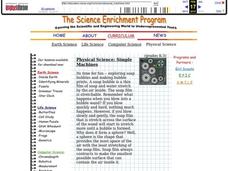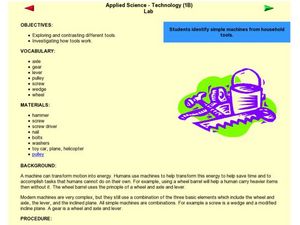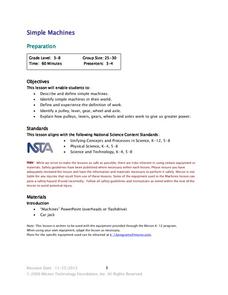Curated OER
Pulleys and Gears
Students analyze an engineering problem. They contrast paper and pencil mastery of concepts with hands-on mastery. They present their design and rationale behind it, whether it works or not.
Curated OER
Applied Science - Technology (2A) Post Lab
Second graders explore simple machines. In this technology lesson, 2nd graders look at pulleys and gears and what the uses are for each. They complete a worksheet comparing the two.
Curated OER
Wheels, Gears, and Compound Machines
Fifth graders read selected pages from their science text and explain forces affected by wheels and axles. They read and discover that gears transfer forces and that gear combinations relate to compound machines.
Curated OER
Machinery In Society
Students explore technology by completing a worksheet in class. In this common machinery lesson plan, students define the different designs that make simple machines work such as wheels, pulleys and gears. Students utilize verbs to...
Curated OER
Can You Bear It? Pulleys, Gears, Forces, Structures and Mechanisms
Students review the types of simple machines. As a class, they focus on the positives and negatives of pulleys and gears and identify what pulleys and gears change of an object. They work together to design their own object to support a...
Curated OER
Applied Science - Technology (2A) Lab
Second graders experiment with simple machines. In this machine lesson, 2nd graders go to different labs to see examples of a lever, inclined plane, wedge, pulley, gears, and wheel and axle. They discuss how a machine makes work a lot...
Curated OER
Simple Machines
Students discover what simple machines are and identify a gear, a pulley, and a lever. In teams, they build at least two models each of simple machines and challenge them with specific instruction cards. Finally, students present and...
Curated OER
Simple Machines
Pupils research simple machines. In this simple machines lesson, students explore the many types of simple machines such as the lever, pulley, and screw. Pupils discover simple machines in the classroom.
Curated OER
Simple Machines in the Home
Students explore simple machines used in the home. In this simple machines lesson, students discover that many household items are constructed from simple machines. Students interact with nutcrackers, peelers, egg slicers, and egg beaters.
Agriculture in the Classroom
Six Kinds Do It All
Teach young engineers that all machines, no matter how complicated or complex, are made up of just six simple devices with this hands-on physical science lesson. Using the included templates, students first create paper models of...
Purdue University
Simple Machines
What's the best way to use a simple machine to solve a real-world problem? Scholars construct their own simple and complex machines to explore the concepts of work and force. They discuss examples of simple machines they have found in...
Curated OER
Household Tools
Students explore parts of a system. In this simple machines lesson, students discover that simple machines are composed of two or more systems. Students examine household tools and assess the parts of the system.
Curated OER
Work and the Farm
Students listen to a lecture by the teacher about farm work and ways to use physics to make farm work easier. The machines that are highlighted include pulleys, ramps, lever, and gears. Each machine is explained in context of its use in...
Curated OER
Ratios And Scale
students investigate the concept of using a ratio in the work of construction and solve problems using real life applications. They read descriptions of how various types of construction professionals use ratios on the job. The...
Curated OER
Simple Machines
Learners engage in a lesson that explores the concept of simple machines. They view a powerpoint media presentation and then are introduced to adult volunteers for the lesson. Each volunteer is at a station with a simple machine and...
Curated OER
Simple Machine Research
Fifth graders demonstrate the ability to use scientific skills and Processes to describe forces that act upon objects to cause specific changes in motion. They identify and describe a science problem related to forces and simple machines.
Curated OER
Mathematical Modeling, Circular Movement and Transmission Ratios
Pupils perform an experiment with different sizes of followers (from an easy to follow set of teacher directions) and record their observations. They test the rotations of the driver compared to the rotations of a follower and put the...
Curated OER
Exploring Simple Machines
Students investigate simple machines. In this simple machines lesson, students study how simple machines work. Students determine the function of various simple machines.
Curated OER
QuickTime Science Project
Fifth graders divide into teams and select a simple science topic to explain and illustrate. They should pick a topic that they can illustrate with a very short (about 15-20 seconds) video clip, or QuickTime movie.
Curated OER
Simple Machines
Fourth graders choose a simple machine and write about they way they believe it will work. Students experiment, write down procedures used and record observations. They will find a picture of the machine and add it to their report.
Curated OER
Newton's Second Law: Mass-Acceleration Relationship with Dynamics Carts
High schoolers form their own hypothesis about the relationships between force, mass, and acceleration for their dynamics cart system. They collect data and express it in a graphical format to visualize the relationships.
Other popular searches
- Medieval Pulleys and Gears
- Gears and Pulleys
- Pulleys and Gears Together
- Pulleys and Gears Worksheets
- Pulleys and Gears Toy
- Pulleys and Gears Togther






















